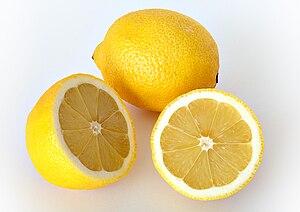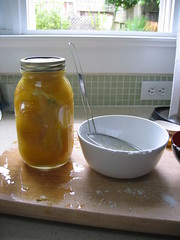 Image by stockingvixen via Flickr
Image by stockingvixen via Flickr
Sunday, October 25, 2009
Want to make Biscotti for the holiday?
Join us for one of two biscotti-making classes: Sunday, Nov. 8 or Sunday, Dec. 6
Noon – 3 p.m., Danbury, Conn.
Class size limited so register now!
Call (203) 733-8176 or e-mail coifedtocook@sbcglobal.net
Lemon logic
Remember when you were young and hanging out on the beach with your friends? It was summer then. The saltwater and sun in your hair made you beautiful and the rest of your life somehow stretched before you, promising more of the same. You squeezed fresh lemon (or bottled lemon juice) and combed through your wet hair to brighten the color.
 Image via Wikipedia
Image via Wikipedia
You’re grown-up now, so this technique works best if you’re sitting in the sun on a sunny beach in the Caribbean (as long as we’re dreaming).
Sunday, October 18, 2009
Moroccan Chicken Tagine with Preserved Lemons over Couscous
Plan this dish at least a month in advance if you plan to preserve the lemons. Or, you can buy them in specialty stores.
For a printable version click here.
 Image by sethfrantzman via Flickr
Image by sethfrantzman via Flickr
1 tablespoon olive oil
1 large onion, thinly sliced
2 cloves garlic, chopped
1 whole chicken, cut into 8 serving pieces
1 teaspoon ground turmeric
1 tablespoon cilantro, chopped
1 1/2 cups chicken stock
rind of 1 preserved lemon, cut into slivers (recipe below)
Kosher salt and freshly ground black pepper to taste
Fresh cilantro to garnish
2 cups couscous, cooked as directed
Heat the oil in the bottom of a tagine or a large Dutch oven. Saute onion and garlic over moderate heat for five minutes until onion is translucent and soft (but not brown).
Raise the heat, add the chicken pieces, and brown evenly turning often. Add the turmeric, cilantro, chicken stock, salt and pepper, and bring to a simmer.
Meanwhile rinse the pieces of lemon in cold running water and with a sharp chef knife trim the flesh and white pith of the lemon and discard. Cut the softened rind into thin strips and stir into the chicken.
Cover and cook very slowly for about 1 1/2 hours. Remove lid and if necessary, boil rapidly to reduce and thicken.
Garnish with fresh cilantro before serving with couscous.
Serves four.
Preserved Lemons
For a printable version click here.
 Image by jfraser via Flickr
Image by jfraser via Flickr
1/4 teaspoon whole peppercorns
1/4 teaspoon whole cloves
Want to pay less for your produce?
When you walk through the aisle, are you one of the many who feel reassured that the water sprinkler keeps the lettuce from drying out? This feature might also keep you from staying in your budget. Yes, it’s keeping the produce crisp and fresh, but it’s also adding weight and cost to the price of your purchase. So when you pick out you’re your lettuce, shake it before buying.
 Image via Wikipedia
Image via Wikipedia
Sunday, October 11, 2009
Pasta Maddalena

For a printable version click here

½ cup pignoli nuts
½ cup soft breadcrumbs (homemade preferable)
½ cup grated Parmesan cheese
3 tablespoons extra-virgin olive oil
1 large onion, cut in half and sliced thin
4 large cloves of garlic sliced
1 large head of cauliflower (cut into small florets)
3 large fresh tomatoes (peeled and crushed) or 1-½ cups of tomato sauce (homemade or jarred, not canned)
2 tablespoons tomato paste
1 cup chicken or vegetable stock
¼ cup dry sherry or white wine
1 pound short pasta
kosher salt and freshly ground pepper to taste
In a small dry non-stick skillet, toast pignoli nuts until golden and set aside.
In same non-stick skillet add 1 Tablespoon oil and toast the breadcrumbs until golden brown.
Set breadcrumbs aside to cool and then stir in grated cheese. Put this mixture aside.
In a large deep skillet or Dutch oven, heat remaining 2 tablespoons oil and cook onion until soft, about 5 minutes. Add garlic and cook about 2 minutes more. Add the cauliflower florets, tomatoes/sauce, tomato paste, stock, dry sherry and currants. (If using raisins add at end of cooking time.) Bring to a simmer, cover and cook until cauliflower is tender, about 15-20 minutes. Remove from heat and stir in basil pesto. Adjust final seasoning of salt and pepper.
 Image via Wikipedia
Image via Wikipedia
Meanwhile bring a large pot of water to a boil and add salt to taste. Cook pasta according to directions and drain.
Sunday, October 4, 2009
The 00s
Cooking with a conscience
Welcome to the third millennium, a sober time marked thus far by war and economic uncertainty –– never mind competing values in our lives. Although generally pleased with the instant communication available to us via the Internet, many of us welcome the opportunity to slow things down when we can. Yes, we appreciate having good take-out at our fingertips, but we also like the idea of planning and creating a meal to share with those we love.
The slow food movement, for example, is a growing worldwide trend that links the pleasure of
 Image via Wikipedia
Image via Wikipedia
No surprise that these days more of us busy folks are finding time to cook for self, family and friends. Some of it is belt-tightening; most of us are eating out less and when we are, we’re doing so on a less-grand scale. But also something about the 9/11 tragedy has brought us together –– in a crazy way, even alerted us to the humanity, culture and cuisine of the Middle East whose millions got dragged by a violent comparative few into the tragedy that has affected us all.
 Image via Wikipedia
Image via Wikipedia
Now when we cook, we invest our American and international creations with fresh produce and organic products. Since 1990, the demand for organic has grown nearly 25 percent a year. We’re buying locally, often creating a feast around a seasonal crop or market. All-you-can-eat fat-and-carb-laden meals where quantity overshadows quality seem to be a thing of the past. Most fast food chains now offer an array of salads and nutritious meals, which means we can choose to stay on the diet straight-and-narrow when we need to eat fast.
The super-size mentality still exists, of course; everything from food to the square-footage of homes will always be subject to the concept in our collective unconscious that “bigger is better.” But as global warming and political unrest rises, as the roller coaster economy barrels towards the next decade, many are choosing non-processed, in-season food not only for pleasure and nourishment but as the answer to world hunger, as well.
It’s all about the comfort to be found in food. That’s why we call the best of it “comfort food.” We master a recipe, then alter it to our taste. In the same way, we style our hair any damn way we please these days: short, chic and highlighted like Senator Clinton or long, dark and glamorous a la Governor Palin.
New ground is being broken –– some of it in our lives, some in the kitchen. Busier than ever,
 Image via Wikipedia
Image via Wikipedia
So strap on your food GPS system and let’s take a tour of the most popular foods that have defined the first decade of this century. Happy eating!



![Reblog this post [with Zemanta]](http://img.zemanta.com/reblog_e.png?x-id=b0d25229-5b9a-4a1b-9a38-86009d9f6d24)